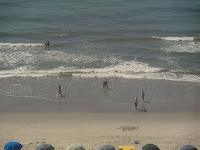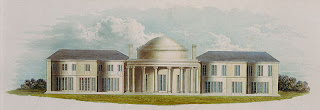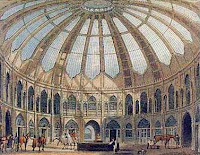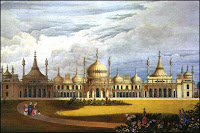Do you enjoy photography or sketching? What are your favorite subjects? Do you have a preference for romanticized images or realistic?

Do you enjoy photography or sketching? What are your favorite subjects? Do you have a preference for romanticized images or realistic?
 Today I’m swamped with a writing deadline and a minor family delay and to top it off, I’m also a guest at USA Today’s Happy Ever After blog (Stop by and say hi–please!!!).
Today I’m swamped with a writing deadline and a minor family delay and to top it off, I’m also a guest at USA Today’s Happy Ever After blog (Stop by and say hi–please!!!).
So I’m going to cheat a little here at Risky Regencies and give you a redux of a blog I wrote in 2009.
But I can’t start the week without saying a “WAY TO GO” to London and the UK for a fabulously done Olympics! I didn’t get to watch as much as I would have liked, but I kept up with the highlights and am proud of our USA team (especially the women) and of the British team, coming in THIRD in medal count. That is amazing. Something to add to that British pride so greatly showcased throughout the whole Olympics.
Back to my old blog….When in doubt (or on deadline) who can you turn to but Wellington? I mean, he saved the day from Napoleon, didn’t he?
Here’s the text of the 2009 blog:
As a certified Wellington Groupie (Kristine Hughes is the founding member) and in continuing honor of the Waterloo Anniversary, I thought I would simply share some of my Wellington-related photos and thoughts.
 When I first fell in raptures about Wellington (or dear Artie, as Kristine calls him), it was at Stratfield Saye, Wellington’s country house. Of all the houses we saw on that 2003 trip to England, Stratfield Saye seemed the most like it was a home. It was a home. The present duke’s son and his family live there, but you could still feel the first Duke in every room. An outer building housed the funeral carriage that carried the Duke’s body through London. A recording played of all his honors, as had been read out during his funeral. I realized that this had been a truly great man.
When I first fell in raptures about Wellington (or dear Artie, as Kristine calls him), it was at Stratfield Saye, Wellington’s country house. Of all the houses we saw on that 2003 trip to England, Stratfield Saye seemed the most like it was a home. It was a home. The present duke’s son and his family live there, but you could still feel the first Duke in every room. An outer building housed the funeral carriage that carried the Duke’s body through London. A recording played of all his honors, as had been read out during his funeral. I realized that this had been a truly great man.

 On that trip we also got to go up to the top of the Wellington Arch in London, and of course we toured Apsley House, also known as Number One London. Apsley House felt more like a museum than a house and well it should. It was filled with wonderful art and artifacts.
On that trip we also got to go up to the top of the Wellington Arch in London, and of course we toured Apsley House, also known as Number One London. Apsley House felt more like a museum than a house and well it should. It was filled with wonderful art and artifacts.
 Also in London we visited Lock and Co, a Hatters shop that has been in Mayfair since 1676. On display there are Wellington’s and Nelson’s hats, instantly recognizable.
Also in London we visited Lock and Co, a Hatters shop that has been in Mayfair since 1676. On display there are Wellington’s and Nelson’s hats, instantly recognizable.
I don’t claim to be an expert on Wellington. I’ve just read one biography (and can’t remember which one it was), but I think of him as a man with great integrity, courage and honor. As a boy he didn’t show much promise, but his mother sent him to a military academy in Europe (near Waterloo, I think) and he found his strength. As a military man he understood how to use his resources, he was clever, and he was brave. He rode the battlefield during Waterloo, was everywhere he could be and ignored the danger to himself. He cared about his men. One of my favorite Wellington quotes is: “Nothing except a battle lost can be half so melancholy as a battle won.”
He was not a good husband, although he felt honor-bound to marry his wife, because she thought they were betrothed and had waited for him while he served in India. He had many dalliances throughout their marriage and one has to wonder how his wife felt as this man grew in greatness and increasingly left her behind. His sons could not match his success. Who could? I like this quote from his son after the Duke’s death, “Imagine what it will be when the Duke of Wellington is announced, and only I walk in the room.”
 The Duke was a man who was very sure of himself and his opinions. I suspect he had a big ego, but he also had a sense of humor. In the display at Lock and Co. was a little caricature of Wellington, making fun of the term Wellington boot for the style of boot he favored. At Stratfield Saye there was a room papered with hundreds of caricatures of the Duke, which I thought was akin to a writer papering a bathroom with rejection letters. The boot one was was there, too.
The Duke was a man who was very sure of himself and his opinions. I suspect he had a big ego, but he also had a sense of humor. In the display at Lock and Co. was a little caricature of Wellington, making fun of the term Wellington boot for the style of boot he favored. At Stratfield Saye there was a room papered with hundreds of caricatures of the Duke, which I thought was akin to a writer papering a bathroom with rejection letters. The boot one was was there, too.
What is your opinion of the Duke of Wellington? Pro and Con. Any favorite quotes or vignettes of his life?
Back to 2012…Or what was your favorite Olympic moment?
A Not So Respectable Gentleman? is still on sale! Get it while you can and enter my new contest!
Next week I promise something original….
 Today, August 16, is the anniversary of the Peterloo Massacre of 1816 when a peaceful meeting of people seeking reform of the Parliamentary system were attacked by the military, leaving eleven dead and over five hundred wounded.
Today, August 16, is the anniversary of the Peterloo Massacre of 1816 when a peaceful meeting of people seeking reform of the Parliamentary system were attacked by the military, leaving eleven dead and over five hundred wounded.
Organized by the Manchester Patriotic Union Society, a large crowd of millworkers from all over Lancashire gathered in St. Peters Field, Manchester that day–anywhere between 30,000 and 153,00, depending on which source you believe–to hear Henry “Orator” Hunt and others speak. It was apparently a glorious summer day and there was a holiday atmosphere, with people wearing their Sunday best.
Local magistrates, however, were convinced the meeting would become a riot, and had arranged for troop to stand by. They sent in the local militia, the Manchester and Salford Yeomanry, who attacked the cart that formed the speakers’ platform. The 15th Hussars were then sent in to “rescue” the Yeomanry and although at first people tried to stand their ground by linking hands, they were cut down and forced to flee–many were hurt by being trampled in the panic. The speakers and newspaper reporters were arrested and imprisoned.
The woman in the white dress on the platform is thought to be Mary Hildes, a passionate radical who formed the Manchester Female Reform Group, and was one of the main speakers at Peterloo. She was also an early proponent of birth control and when she attempted to distribute books on the subject she was accused in the local press of selling pornography. The women radicals didn’t campaign, though, for female suffrage, but supported the male radical cause. They weren’t taken seriously by the press (of course. Note the dirty implications in the drawin, the kneejerk reaction of a Georgian cartoonists). They weren’t even taken seriously by other women. As The Times reported that day:
A group of women of Manchester, attracted by the crowd, came to the corner of the street where we had taken our post. They viewed the Oldham Female Reformers for some time with a look in which compassion and disgust was equally blended, and at last burst out into an indignant exclamation–“Go home to your families, and leave sike-like as these to your husbands and sons, who better understand them.”
 Many were outraged by the massacre, including local mill owners who witnessed it. James Wroe of the Manchester Observer was probably the first to call the massacre “Peterloo,” in ironic reference to Waterloo. The government supported the action of the troops, and by the end of the year had passed the infamous Six Acts that suppressed freedom of speech and of the press and made radical gatherings illegal. There wasn’t a public enquiry into Peterloo until 1820. It wasn’t until 1832 that the Reform Bill corrected some of the worst injustices of the electoral system and in 1918 all men, and women over 30, were given the vote.
Many were outraged by the massacre, including local mill owners who witnessed it. James Wroe of the Manchester Observer was probably the first to call the massacre “Peterloo,” in ironic reference to Waterloo. The government supported the action of the troops, and by the end of the year had passed the infamous Six Acts that suppressed freedom of speech and of the press and made radical gatherings illegal. There wasn’t a public enquiry into Peterloo until 1820. It wasn’t until 1832 that the Reform Bill corrected some of the worst injustices of the electoral system and in 1918 all men, and women over 30, were given the vote.
 This is based on a post I did five–aargh, five years ago. There’s now a campaign to get an official memorial to the Peterloo Massacre since it was such a significant part of Manchester’s history. Here’s a picture from their Facebook page taken today of a demonstrator on the site–you can see how it’s changed–holding aloft a liberty cap.
This is based on a post I did five–aargh, five years ago. There’s now a campaign to get an official memorial to the Peterloo Massacre since it was such a significant part of Manchester’s history. Here’s a picture from their Facebook page taken today of a demonstrator on the site–you can see how it’s changed–holding aloft a liberty cap.
So what was the situation before 1832? About one in ten men could vote, because the right to vote was tied in to income and property and the areas represented ignored population shifts. Over sixty “Rotten Boroughs,” scarcely populated areas, or “Pocket Boroughs,” shoo-ins for local landowners were represented, but the huge industrial towns like Manchester were barely represented at all. Also voting was not done by ballot, so the few who could vote could easily be coerced or bribed. Middlemarch by George Eliot is set in this period.
I commented in 2007 that we don’t see too many books about the “real” history of the Regency but I think that’s changed. On the other hand we also seem to have more dukes to balance things out. How do you think things have changed in romance and in the fictional depiction of the Regency?
 When my children were young, this was the time of year we would always spend a week at the beach. My In-laws then owned a condo at North Myrtle Beach, SC, and every year we would vacation there. It was a great condo, right on the beach, on the third floor and facing the ocean. It had three bedrooms and two full baths, plus a screened in balcony. We went there so many years that it felt like home and North Myrtle Beach was nearly as familiar as our neighborhood.
When my children were young, this was the time of year we would always spend a week at the beach. My In-laws then owned a condo at North Myrtle Beach, SC, and every year we would vacation there. It was a great condo, right on the beach, on the third floor and facing the ocean. It had three bedrooms and two full baths, plus a screened in balcony. We went there so many years that it felt like home and North Myrtle Beach was nearly as familiar as our neighborhood.
During the Regency, the Prince Regent also owned a “beach house.” His house was at the beach resort town of Brighton and he, too, “vacationed” there.
 The Prince first visited Brighton in 1783 at aged twenty-one, in the company of his fast-living uncle, The Duke of Cumberland, partly to escape the constraints of his father’s court and partly for health reasons. His physicians thought sea-bathing would ease the swelling of glands of his neck. By 1786 he purchased a modest Brighton residence and shortly thereafter he hired Henry Hollard to build him a grander residence, a neo-classical structure with a central domed rotunda surrounded by Ionic columns. His residence was nearby the villa where he’d installed Mrs. Fitzherbert, his secret wife.
The Prince first visited Brighton in 1783 at aged twenty-one, in the company of his fast-living uncle, The Duke of Cumberland, partly to escape the constraints of his father’s court and partly for health reasons. His physicians thought sea-bathing would ease the swelling of glands of his neck. By 1786 he purchased a modest Brighton residence and shortly thereafter he hired Henry Hollard to build him a grander residence, a neo-classical structure with a central domed rotunda surrounded by Ionic columns. His residence was nearby the villa where he’d installed Mrs. Fitzherbert, his secret wife.
 The Prince’s presence in Brighton was a boon to the town’s economy. Soon the fashionable world followed him to Brighton, and more elegant residences were built for them. Brighton remained the fashionable place for the elite to spend their summers. During these years the Prince hired architect P. F. Robinson to expand the beach house. He also purchased the land around what was named the Marine Pavilion. The stable he had built between 1803 and 1808, in the Indian style, soon dwarfed the pavilion. There was nothing to do but make his beach house even grander.
The Prince’s presence in Brighton was a boon to the town’s economy. Soon the fashionable world followed him to Brighton, and more elegant residences were built for them. Brighton remained the fashionable place for the elite to spend their summers. During these years the Prince hired architect P. F. Robinson to expand the beach house. He also purchased the land around what was named the Marine Pavilion. The stable he had built between 1803 and 1808, in the Indian style, soon dwarfed the pavilion. There was nothing to do but make his beach house even grander.
 By this time (1815) the Prince had became Prince Regent, and he hired John Nash as the architect to redesign the exterior. The Prince Regent wanted the house built in an Indian style, like the stables. Nash had never traveled to India, but he was inspired by drawings in William and Thomas Daniell’s four volume Oriental Scenery and the result is the building as it appears today.
By this time (1815) the Prince had became Prince Regent, and he hired John Nash as the architect to redesign the exterior. The Prince Regent wanted the house built in an Indian style, like the stables. Nash had never traveled to India, but he was inspired by drawings in William and Thomas Daniell’s four volume Oriental Scenery and the result is the building as it appears today.
The interiors of the Pavilion were designed by Frederick Crace and Robert Jones and their rooms are a remarkable sight to see. I was lucky enough to visit the Royal Pavilion in 2003 and walked through those rooms. These images can’t quite do them justice. The house was completed in 1823. By that time the Prince had become King George IV.
 The Royal Pavilion, in my opinion, is the perfect beach house, because it is decorated in a style you’d never live with at home. It just skirts the boundary between beautiful and tacky (but lands mostly on the beautiful side).
The Royal Pavilion, in my opinion, is the perfect beach house, because it is decorated in a style you’d never live with at home. It just skirts the boundary between beautiful and tacky (but lands mostly on the beautiful side).
Amanda, remember that the Royal Pavilion does weddings! You could be married in the Grand Saloon and have your wedding sit-down in the dining room!! I’d so totally come for it!
Where is your favorite beach vacation? And do you think Amanda should be married in Brighton at the Royal Pavilion?